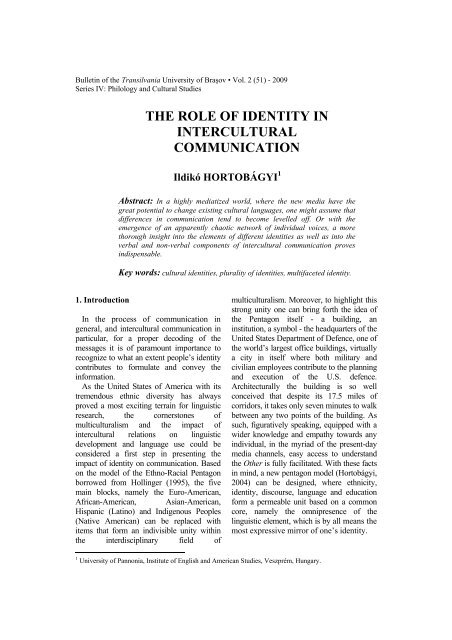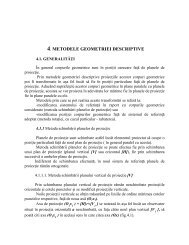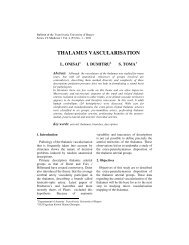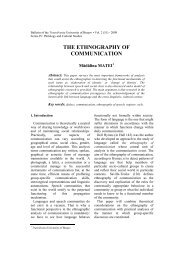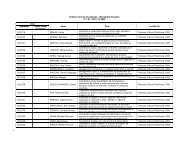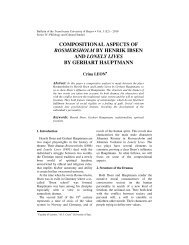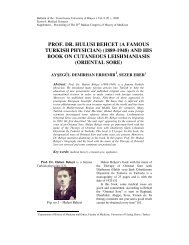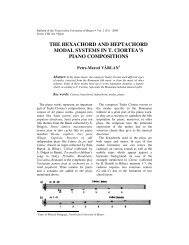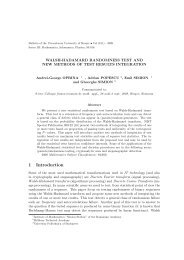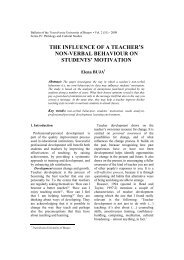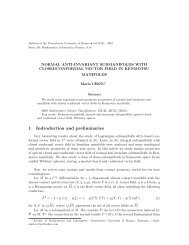Hortobágyi, I.: The Role of Identity in Intercultural Communication
Hortobágyi, I.: The Role of Identity in Intercultural Communication
Hortobágyi, I.: The Role of Identity in Intercultural Communication
You also want an ePaper? Increase the reach of your titles
YUMPU automatically turns print PDFs into web optimized ePapers that Google loves.
Bullet<strong>in</strong> <strong>of</strong> the Transilvania University <strong>of</strong> Braşov • Vol. 2 (51) - 2009<br />
Series IV: Philology and Cultural Studies<br />
THE ROLE OF IDENTITY IN<br />
INTERCULTURAL<br />
COMMUNICATION<br />
Ildikó HORTOBÁGYI 1<br />
Abstract: In a highly mediatized world, where the new media have the<br />
great potential to change exist<strong>in</strong>g cultural languages, one might assume that<br />
differences <strong>in</strong> communication tend to become levelled <strong>of</strong>f. Or with the<br />
emergence <strong>of</strong> an apparently chaotic network <strong>of</strong> <strong>in</strong>dividual voices, a more<br />
thorough <strong>in</strong>sight <strong>in</strong>to the elements <strong>of</strong> different identities as well as <strong>in</strong>to the<br />
verbal and non-verbal components <strong>of</strong> <strong>in</strong>tercultural communication proves<br />
<strong>in</strong>dispensable.<br />
Key words: cultural identities, plurality <strong>of</strong> identities, multifaceted identity.<br />
1. Introduction<br />
In the process <strong>of</strong> communication <strong>in</strong><br />
general, and <strong>in</strong>tercultural communication <strong>in</strong><br />
particular, for a proper decod<strong>in</strong>g <strong>of</strong> the<br />
messages it is <strong>of</strong> paramount importance to<br />
recognize to what an extent people’s identity<br />
contributes to formulate and convey the<br />
<strong>in</strong>formation.<br />
As the United States <strong>of</strong> America with its<br />
tremendous ethnic diversity has always<br />
proved a most excit<strong>in</strong>g terra<strong>in</strong> for l<strong>in</strong>guistic<br />
research, the cornerstones <strong>of</strong><br />
multiculturalism and the impact <strong>of</strong><br />
<strong>in</strong>tercultural relations on l<strong>in</strong>guistic<br />
development and language use could be<br />
considered a first step <strong>in</strong> present<strong>in</strong>g the<br />
impact <strong>of</strong> identity on communication. Based<br />
on the model <strong>of</strong> the Ethno-Racial Pentagon<br />
borrowed from Holl<strong>in</strong>ger (1995), the five<br />
ma<strong>in</strong> blocks, namely the Euro-American,<br />
African-American, Asian-American,<br />
Hispanic (Lat<strong>in</strong>o) and Indigenous Peoples<br />
(Native American) can be replaced with<br />
items that form an <strong>in</strong>divisible unity with<strong>in</strong><br />
the <strong>in</strong>terdiscipl<strong>in</strong>ary field <strong>of</strong><br />
multiculturalism. Moreover, to highlight this<br />
strong unity one can br<strong>in</strong>g forth the idea <strong>of</strong><br />
the Pentagon itself - a build<strong>in</strong>g, an<br />
<strong>in</strong>stitution, a symbol - the headquarters <strong>of</strong> the<br />
United States Department <strong>of</strong> Defence, one <strong>of</strong><br />
the world’s largest <strong>of</strong>fice build<strong>in</strong>gs, virtually<br />
a city <strong>in</strong> itself where both military and<br />
civilian employees contribute to the plann<strong>in</strong>g<br />
and execution <strong>of</strong> the U.S. defence.<br />
Architecturally the build<strong>in</strong>g is so well<br />
conceived that despite its 17.5 miles <strong>of</strong><br />
corridors, it takes only seven m<strong>in</strong>utes to walk<br />
between any two po<strong>in</strong>ts <strong>of</strong> the build<strong>in</strong>g. As<br />
such, figuratively speak<strong>in</strong>g, equipped with a<br />
wider knowledge and empathy towards any<br />
<strong>in</strong>dividual, <strong>in</strong> the myriad <strong>of</strong> the present-day<br />
media channels, easy access to understand<br />
the Other is fully facilitated. With these facts<br />
<strong>in</strong> m<strong>in</strong>d, a new pentagon model (Hortobágyi,<br />
2004) can be designed, where ethnicity,<br />
identity, discourse, language and education<br />
form a permeable unit based on a common<br />
core, namely the omnipresence <strong>of</strong> the<br />
l<strong>in</strong>guistic element, which is by all means the<br />
most expressive mirror <strong>of</strong> one’s identity.<br />
1 University <strong>of</strong> Pannonia, Institute <strong>of</strong> English and American Studies, Veszprém, Hungary.
258<br />
Bullet<strong>in</strong> <strong>of</strong> the Transilvania University <strong>of</strong> Braşov • Vol. 2 (51) - 2009 • Series IV<br />
2. From E Pluribus Unum to E Pluribus<br />
Plures<br />
Accord<strong>in</strong>g to Kallen (Ste<strong>in</strong>berg, 2000),<br />
the United States is less importantly a<br />
union <strong>of</strong> states than it is a union <strong>of</strong> ethnic,<br />
racial, and religious groups – a union <strong>of</strong><br />
otherwise unrelated “natives”. <strong>The</strong> Great<br />
Seal <strong>of</strong> the United States carries the motto<br />
E pluribus unum, “from many, one”, which<br />
seems to suggest that manyness must be<br />
left beh<strong>in</strong>d for the sake <strong>of</strong> oneness. Once<br />
there were many, now they have merged<br />
or, <strong>in</strong> Israel Zangwill’s classic image, have<br />
been melted down <strong>in</strong>to one. But the Great<br />
Seal also presents a different image: the<br />
American eagle holds a sheaf <strong>of</strong> arrows.<br />
Here there is no merger or fusion but only<br />
a fasten<strong>in</strong>g, a putt<strong>in</strong>g together: many-<strong>in</strong>one.<br />
<strong>The</strong> adjective American seems to<br />
describe this k<strong>in</strong>d <strong>of</strong> oneness and would<br />
po<strong>in</strong>t rather to the citizenship than nativity<br />
or nationality. <strong>The</strong> history <strong>of</strong> the American<br />
society has proved a pluralism, <strong>in</strong> which<br />
there is no movement from many to one,<br />
but rather simultaneity and coexistence, a<br />
group affiliation so remarkably expressed<br />
by the motto <strong>of</strong> the 21st century: E<br />
pluribus plures, “from many, many”.<br />
2.1. <strong>Identity</strong> – a Monolithic or a<br />
Dynamic Category?<br />
Presently one can choose one’s roots<br />
freely, bear<strong>in</strong>g <strong>in</strong> m<strong>in</strong>d that the United<br />
States is endowed with a non-ethnic<br />
ideology <strong>of</strong> the nation, has a<br />
predom<strong>in</strong>antly ethnic history and can<br />
create for itself a post-ethnic future <strong>in</strong><br />
which affiliation on the basis <strong>of</strong> shared<br />
descent is more voluntary than prescribed.<br />
In each ethnic, racial, cultural or genderrelated<br />
speech community language use is<br />
<strong>of</strong> vital importance. Although each<br />
<strong>in</strong>dividual community has its own norms,<br />
codes and forms <strong>of</strong> communication,<br />
language is used not only as a means <strong>of</strong><br />
communication but also as a marker <strong>of</strong> the<br />
speaker’s cultural identity. A speech<br />
community may decide to ma<strong>in</strong>ta<strong>in</strong> the<br />
commonly agreed rules and norms, but<br />
may just as well decide to gradually<br />
change them accord<strong>in</strong>g to the<br />
communication environment. In addition,<br />
<strong>in</strong> all communities there is a certa<strong>in</strong><br />
<strong>in</strong>dividual deviation from the norms, as not<br />
all the members <strong>of</strong> a speech community<br />
communicate <strong>in</strong> the same way <strong>in</strong> a specific<br />
situation or <strong>in</strong>teraction.<br />
In a multicultural sett<strong>in</strong>g, when engag<strong>in</strong>g<br />
<strong>in</strong>to a conversation, one has to presuppose<br />
that the members <strong>of</strong> a speech group usually<br />
share the same code and an entire system<br />
<strong>of</strong> symbols, signs and mean<strong>in</strong>gs. By<br />
def<strong>in</strong>ition, we speak about <strong>in</strong>tercultural<br />
communication when the participants who<br />
communicate represent a different<br />
communication system. Differences, which<br />
may <strong>of</strong>ten lead to clashes or even conflicts,<br />
occur both at verbal level – certa<strong>in</strong><br />
expressions can be employed to assert<br />
belong<strong>in</strong>g to a group or on the contrary to<br />
discrim<strong>in</strong>ate and exclude – and at nonverbal<br />
level, when for <strong>in</strong>stance eyecontact,<br />
gestures, turn tak<strong>in</strong>g can be<br />
determ<strong>in</strong>ed by the speaker’s identity.<br />
In the complex background <strong>of</strong> the rapidly<br />
evolv<strong>in</strong>g political, socio-economic and<br />
f<strong>in</strong>ancial world, cultural identities become<br />
multifaceted, thus <strong>of</strong>ten display<strong>in</strong>g<br />
different degrees <strong>of</strong> ambiguity. In the<br />
process <strong>of</strong> socialization, under the<br />
<strong>in</strong>fluence <strong>of</strong> the above mentioned factors,<br />
the cultural groups reflect the surround<strong>in</strong>g<br />
reality; consequently they are cont<strong>in</strong>uously<br />
negotiat<strong>in</strong>g, re-enforc<strong>in</strong>g or on the contrary<br />
redef<strong>in</strong><strong>in</strong>g their cultural and ethnic<br />
identities to fit societal needs. This process<br />
<strong>of</strong> reshap<strong>in</strong>g also depends on the amount<br />
<strong>of</strong> personal history and experiences<br />
embedded <strong>in</strong> the current socio-economic<br />
realities <strong>of</strong> each society.<br />
In the turmoil <strong>of</strong> new types <strong>of</strong> regional<br />
conflicts, as early as 1993 Samuel P.
Hortobagyi, I.: <strong>The</strong> <strong>Role</strong> <strong>of</strong> <strong>Identity</strong> <strong>in</strong> <strong>Intercultural</strong> <strong>Communication</strong> 259<br />
Hunt<strong>in</strong>gton’s <strong>in</strong> his paper entitled “<strong>The</strong><br />
Clash <strong>of</strong> Civilizations?”, which led to his<br />
famous book “<strong>The</strong> Clash <strong>of</strong> Civilizations<br />
and the Remak<strong>in</strong>g <strong>of</strong> New World Order”<br />
recognized the paramount need to redef<strong>in</strong>e<br />
and re<strong>in</strong>terpret the role <strong>of</strong> civilizations <strong>in</strong><br />
general and the role <strong>of</strong> the <strong>in</strong>dividual <strong>in</strong><br />
particular. Accord<strong>in</strong>gly, with the end <strong>of</strong> the<br />
Cold War, “the Velvet Curta<strong>in</strong> <strong>of</strong> culture has<br />
replaced the Iron Curta<strong>in</strong> <strong>of</strong> ideology”<br />
(Hunt<strong>in</strong>gton, 1993, 31) <strong>in</strong> a world where<br />
conflicts are usually spread<strong>in</strong>g along the<br />
fault l<strong>in</strong>es separat<strong>in</strong>g the major civilizations,<br />
namely Western, Confucian, Japanese,<br />
Islamic, H<strong>in</strong>du, Slavic-Orthodox, Lat<strong>in</strong><br />
American and African civilizations, which<br />
are basically differentiated from each other<br />
by history, language, culture, tradition and<br />
religion. <strong>The</strong> members <strong>of</strong> these civilizations<br />
also display largely different views on the<br />
basic relations between God and the<br />
<strong>in</strong>dividual, the <strong>in</strong>dividual and the group,<br />
parents and children, husband and wife, the<br />
state and the citizen, rights and<br />
responsibilities, liberty and authority,<br />
equality and hierarchy. Although identities<br />
are basically negotiated and re-negotiated <strong>in</strong><br />
the communication process, cultural<br />
characteristics and differences are less<br />
mutable, thus less easily open to<br />
compromise than political and economic<br />
ones. In a world which is currently<br />
experienc<strong>in</strong>g ideological realignment, an<br />
<strong>in</strong>dividual might chose to change political<br />
affiliation (sometimes even switch<strong>in</strong>g<br />
between two extremes), might have to get<br />
along with an altered economic status, but<br />
cannot and would not deny his/her national<br />
identity. “In class and ideological conflicts,<br />
the key question was “Which side are you<br />
on?”… In conflicts between civilizations,<br />
the question is “What are you?”<br />
(Hunt<strong>in</strong>gton, 1993, 27).<br />
As mentioned above, cultural identities<br />
are <strong>in</strong> fact manifestations <strong>of</strong> social<br />
reality. But what does the concept <strong>of</strong><br />
“cultural identity” cover? Generally<br />
speak<strong>in</strong>g, cultural identities usually<br />
encompass both race and ethnicity, two<br />
categories which develop dur<strong>in</strong>g the<br />
<strong>in</strong>dividual’s early socialization and<br />
constitute the core <strong>of</strong> a person’s drive for<br />
an ethnocentric <strong>in</strong>terpretation <strong>of</strong> the<br />
world. Race is generally <strong>in</strong>terpreted as a<br />
classification <strong>of</strong> an arbitrary selection <strong>of</strong><br />
physical characters which separate<br />
people <strong>in</strong>to value-based categories,<br />
def<strong>in</strong>ed <strong>in</strong> relation to common descent<br />
and heredity. Along this l<strong>in</strong>e, ethnicity<br />
seems to be an extension, an elaborate<br />
prolongation <strong>of</strong> race, as ethnic identity is<br />
primarily a cultural marker that mirrors<br />
not only ancestral orig<strong>in</strong>s, shared<br />
heritage, race and traditions, but also<br />
economic, cultural, religious and<br />
l<strong>in</strong>guistic background. Identified<br />
historically or psychologically, ethnicity<br />
is more an emotional bond shared by the<br />
members <strong>of</strong> a group. S<strong>in</strong>ce it is<br />
extremely difficult to trace the sharp<br />
delimitation <strong>of</strong> these two categories,<br />
from the end <strong>of</strong> the 1990s the terms<br />
ethnicity and race have been less<br />
commonly employed, <strong>in</strong>stead the term<br />
cultural identity has been preferred.<br />
3. Plurality <strong>of</strong> Identities<br />
In communication and daily<br />
<strong>in</strong>teractions people def<strong>in</strong>e who they are<br />
and negotiate their identities with people<br />
who are similar to them or different from<br />
them.<br />
3.1. Types <strong>of</strong> <strong>Identity</strong><br />
Each person has multiple dimensions <strong>of</strong><br />
identities, usually depend<strong>in</strong>g on the nature<br />
<strong>of</strong> the social <strong>in</strong>teraction. <strong>The</strong> sources <strong>of</strong><br />
identity range as follows (Hunt<strong>in</strong>gton,<br />
2004, 27):<br />
Ascriptive (age, ancestry, gender, k<strong>in</strong><br />
(blood relatives), ethnicity (extended k<strong>in</strong>),<br />
race);
260<br />
Bullet<strong>in</strong> <strong>of</strong> the Transilvania University <strong>of</strong> Braşov • Vol. 2 (51) - 2009 • Series IV<br />
Cultural (clan, tribe, ethnicity (way <strong>of</strong><br />
life), language, nationality, religion,<br />
civilization);<br />
Territorial (neighbourhood, settlement,<br />
country, geographical area, hemisphere,<br />
etc.);<br />
Political (faction, clique, leader, <strong>in</strong>terest<br />
group, movement, party, ideology, state,<br />
etc.);<br />
Economic (job, occupation, pr<strong>of</strong>ession,<br />
work group, employer, <strong>in</strong>dustry, economic<br />
sector, labour union, class);<br />
Social (friends, club, team, colleagues,<br />
leisure group, status).<br />
3.2. Properties <strong>of</strong> <strong>Identity</strong><br />
When deal<strong>in</strong>g with the properties <strong>of</strong><br />
identity, we dist<strong>in</strong>guish two basic elements<br />
i.e. avowal (how a person perceives himself<br />
or herself) and ascription (how others<br />
perceive and communicate a person’s<br />
identity). As far as the modes <strong>of</strong> expression<br />
are concerned, identity expresses itself<br />
through core symbols, names and labels, and<br />
norms. <strong>The</strong> core symbols manifest<br />
themselves <strong>in</strong> the form <strong>of</strong> cultural beliefs,<br />
which are actually people’s <strong>in</strong>terpretation <strong>of</strong><br />
the world and <strong>of</strong> the function<strong>in</strong>g society. In<br />
addition, cultural groups, which share these<br />
core symbols, create norms for proper<br />
conduct and appropriate behaviour <strong>in</strong><br />
relational contacts.<br />
Social and cultural identities may just as<br />
well be classified accord<strong>in</strong>g to the<br />
follow<strong>in</strong>g taxonomy:<br />
Gender identity, which is <strong>in</strong>fluenced by<br />
the way people are treated <strong>in</strong> every culture.<br />
In each society there are shared norms<br />
accord<strong>in</strong>g to which communication and<br />
<strong>in</strong>teractions are considered either fem<strong>in</strong><strong>in</strong>e<br />
or mascul<strong>in</strong>e. Nowadays the media<br />
<strong>in</strong>fluences what is considered fem<strong>in</strong><strong>in</strong>e or<br />
mascul<strong>in</strong>e identity;<br />
Age identity (cultures treat people <strong>of</strong><br />
different ages <strong>in</strong> different ways; deep<br />
respect or on the contrary lack <strong>of</strong> respect is<br />
usually overtly expressed <strong>in</strong> language);<br />
Spiritual identity (depend<strong>in</strong>g on the<br />
culture and context, spiritual identity can<br />
be more or less apparent, this identity may<br />
sometimes lead to severe conflicts);<br />
Class identity (which usually <strong>in</strong>fluences<br />
the way <strong>in</strong>dividuals communicate with<br />
each other. Often this identity is noticed<br />
only follow<strong>in</strong>g an encounter with a person<br />
represent<strong>in</strong>g another social class);<br />
National identity (a person’s citizenship<br />
<strong>of</strong> a nation, which <strong>of</strong>ten might be dom<strong>in</strong>ant<br />
over the <strong>in</strong>dividual’s cultural identity –<br />
racial and/or ethnic);<br />
Regional identity (which may carry<br />
positive, negative, real or presumed<br />
generalizations about people liv<strong>in</strong>g <strong>in</strong> a<br />
specific region <strong>of</strong> a country, <strong>of</strong>ten this<br />
identity is stronger than the national<br />
identity).<br />
Relations among identities are complex<br />
and <strong>of</strong>ten carry strong elements <strong>of</strong><br />
differentiation. Occasionally an <strong>in</strong>dividual<br />
resid<strong>in</strong>g and work<strong>in</strong>g <strong>in</strong> a multicultural<br />
background has to manage the conflict<br />
between family identity and job identity.<br />
Broader identity (national, cultural) might<br />
<strong>in</strong>clude narrower identities (territorial,<br />
religious), which at times could be<br />
exclusive. People may assert dual<br />
nationality, sometimes dual citizenship, but<br />
very rarely dual religiosity.<br />
In the process <strong>of</strong> communication all the<br />
manifestations <strong>of</strong> a person’s identity are<br />
expressed either through verbal or nonverbal<br />
means. Rarely do people <strong>in</strong>ternalize<br />
that non-verbal communication is a most<br />
powerful form <strong>of</strong> communication.<br />
Multicultural differences <strong>in</strong> body language,<br />
facial expression, use <strong>of</strong> space, and<br />
especially, gestures are <strong>of</strong>ten prone to<br />
mis<strong>in</strong>terpretation. Accord<strong>in</strong>g to a study<br />
concluded at UCLA up to 93 percent <strong>of</strong><br />
communication effectiveness is determ<strong>in</strong>ed<br />
by nonverbal cues. Another study <strong>in</strong>dicates<br />
that the impact <strong>of</strong> a performance was<br />
determ<strong>in</strong>ed 7 percent by the words used,
Hortobagyi, I.: <strong>The</strong> <strong>Role</strong> <strong>of</strong> <strong>Identity</strong> <strong>in</strong> <strong>Intercultural</strong> <strong>Communication</strong> 261<br />
38 percent by voice quality, and 55 percent<br />
by the nonverbal communication.<br />
(Heathfield, 2009).<br />
3. <strong>Identity</strong> and Discourse<br />
A critical post-modern analysis <strong>of</strong> racial<br />
and ethnic categories <strong>of</strong> difference po<strong>in</strong>ts<br />
to the multilayered and fractured<br />
construction <strong>of</strong> <strong>in</strong>dividual identities. Ethnic<br />
identity is socially constructed and can be<br />
reformed <strong>in</strong> discourse and political<br />
struggle. Racial identities are unstable and<br />
have shifted accord<strong>in</strong>g to the drifts <strong>of</strong><br />
political trends. For <strong>in</strong>stance once def<strong>in</strong>ed<br />
by the U.S. Census Bureau by race,<br />
Hispanics are now identified by ethnic<br />
categories as Central American, Mexican-<br />
American, Cuban and so on.<br />
Giroux (Hortobágyi, 2004)) tackles the<br />
radical post-modern notion that identities are<br />
shaped <strong>in</strong> discourse through language use and<br />
the content <strong>of</strong> what for <strong>in</strong>stance students are<br />
allowed to voice <strong>in</strong> the classroom. By<br />
stress<strong>in</strong>g the importance <strong>of</strong> the self, Giroux<br />
argues that little space is available for human<br />
action. In the social context <strong>of</strong> urban<br />
school<strong>in</strong>g, it is clear that much pedagogical<br />
practice rests on the assumption that ethnic<br />
dialects <strong>in</strong>terfere <strong>in</strong> the goal <strong>of</strong> assimilation<br />
for m<strong>in</strong>ority students. Many students <strong>of</strong><br />
multiple cultural background, for example,<br />
immigrants and Mexican-American students<br />
<strong>in</strong> border towns and states, are therefore<br />
silenced or forced to make a choice <strong>of</strong><br />
survival, reject<strong>in</strong>g one <strong>of</strong> the multiple<br />
identities <strong>in</strong> favour <strong>of</strong> assimilation. Clearly,<br />
<strong>in</strong>dividual identities are woven <strong>in</strong> discourse,<br />
privileg<strong>in</strong>g specific use <strong>of</strong> language and<br />
silenc<strong>in</strong>g other uses.<br />
Research on African-American<br />
discourse, verbal genres and <strong>in</strong>teractions<br />
has been copious, cover<strong>in</strong>g the fields <strong>of</strong><br />
l<strong>in</strong>guistics, folklore, anthropology,<br />
sociology, psychology, education, and<br />
literary criticism. <strong>The</strong> way African<br />
Americans talk to each other not only<br />
reveals how languages are socially<br />
constructed, but that speech events,<br />
activities, participants and context display<br />
unpredictable modes <strong>of</strong> expression.<br />
It is also worth mention<strong>in</strong>g that much<br />
research was consecrated to the<br />
exploration <strong>of</strong> verbal and discourse genres<br />
and practices which constitute for <strong>in</strong>stance<br />
the African American speech community.<br />
Discourse genres refer to language and<br />
communication styles which commonly<br />
occur <strong>in</strong> socially, culturally and politically<br />
def<strong>in</strong>ed contexts. In contrast, verbal genres<br />
refer to the speaker’s use <strong>of</strong> culturally<br />
significant varieties and styles which<br />
mediate, constitute and construct contexts.<br />
Thus, while both discourse and verbal<br />
genres may co-construct various contexts,<br />
verbal genres can conflict with strongly<br />
framed discourse norms erod<strong>in</strong>g or<br />
disrupt<strong>in</strong>g well-def<strong>in</strong>ed social contexts.<br />
How can we exploit the advantages <strong>of</strong> a<br />
multicultural or <strong>in</strong>tercultural background?<br />
In the process <strong>of</strong> develop<strong>in</strong>g conscious<br />
sensitivity to decode the messagecarry<strong>in</strong>g<br />
elements <strong>of</strong> identity, it is very<br />
important to presuppose their<br />
omnipresence. <strong>The</strong> first step would be to<br />
admit and recognize the complexity <strong>of</strong><br />
people’s cultural identity <strong>in</strong> terms <strong>of</strong> how<br />
they want to represent themselves. In<br />
case <strong>of</strong> a person who comes from a<br />
country whose society is complex and<br />
multifaceted, the layers and the depth <strong>of</strong><br />
such a complex society are as a rule<br />
visible, thus will be shown <strong>in</strong><br />
communication as well. In these societies<br />
the identity is not only multifaceted but is<br />
also cont<strong>in</strong>uously shift<strong>in</strong>g. Consequently,<br />
<strong>in</strong> order to understand the complexity <strong>of</strong><br />
an event, one has to look at it from<br />
different angles.<br />
3. Conclusion<br />
Successful <strong>in</strong>tercultural communication<br />
should grow from an understand<strong>in</strong>g <strong>of</strong>
262<br />
Bullet<strong>in</strong> <strong>of</strong> the Transilvania University <strong>of</strong> Braşov • Vol. 2 (51) - 2009 • Series IV<br />
people, culture and society <strong>in</strong> general. In<br />
the process <strong>of</strong> conscious multicultural<br />
education it is important to be able to<br />
deconstruct a given experience or situation<br />
and decompose it <strong>in</strong>to discreet elements<br />
which allow greater <strong>in</strong>sight and reveal<br />
presumed sources <strong>of</strong> prejudice. In this<br />
process not so much national differences<br />
are relevant, rather the different senses <strong>of</strong><br />
belong<strong>in</strong>g to community, class, occupation<br />
or gender. Two approaches a successful<br />
management <strong>of</strong> <strong>in</strong>tercultural<br />
communication should follow are the<br />
essentialist and the reductive ones. <strong>The</strong><br />
essentialist approach presumes that there is<br />
a universal essence, homogeneity and unity<br />
<strong>in</strong> each particular culture; whereas the<br />
reductive one argues that cultural<br />
behaviour is reduced to concrete factors.<br />
<strong>The</strong> synergy <strong>of</strong> these two approaches leads<br />
to the development <strong>of</strong> certa<strong>in</strong> basic<br />
pr<strong>in</strong>ciples <strong>in</strong>dispensable while <strong>in</strong>teract<strong>in</strong>g<br />
with different <strong>in</strong>dividuals <strong>in</strong> different<br />
contexts.<br />
“Where do I as an <strong>in</strong>dividual fit <strong>in</strong>to the<br />
global competition and opportunities <strong>of</strong> the<br />
world, how can I, on my own, collaborate<br />
with others globally?” (Friedman, 11) In<br />
the “Global Village” <strong>of</strong> the technologically<br />
flattened world, We and <strong>The</strong>m have to<br />
negotiate our <strong>in</strong>dividual identities to allow<br />
the emergence <strong>of</strong> unbiased, prejudice and<br />
manipulation free communication. <strong>The</strong><br />
construction <strong>of</strong> multiracial and multiethnic<br />
identities has been dynamic over the past<br />
two decades. But all over the world,<br />
educators have to develop radical<br />
pedagogical structures which provide<br />
students with the opportunity to exploit<br />
their own cultural identities and l<strong>in</strong>guistic<br />
realities as a basis <strong>of</strong> oral and written<br />
communication.<br />
References<br />
1. Friedman, Thomas. <strong>The</strong> World is Flat.<br />
2 nd ed. London: Pengu<strong>in</strong> Books, 2006.<br />
2. Heathfield. Susan. “Listen with Your<br />
Eyes. Tips for Understand<strong>in</strong>g<br />
Nonverbal <strong>Communication</strong>.”<br />
About.com.: Human Resources, 2009.<br />
Web 28. 04. 2009.<br />
3. Holliday, Adrian et al. <strong>Intercultural</strong><br />
<strong>Communication</strong>. An Advanced<br />
Resource Book. 2004. London/New<br />
York: Routlege, 2007.<br />
4. Holl<strong>in</strong>ger, D.A. (ed). Haley’s Choice<br />
and the Ethno-Racial Pentagon.<br />
Postethnic America: Beyond<br />
Multiculturalism. New York: Basic<br />
Books, 1995.<br />
5. Hortobágyi, Ildikó. “Ethnicity –<br />
<strong>Identity</strong> – Discourse – Language –<br />
Education: a New Pentagon”. A<br />
Nyelvek Vonzásában (Language<br />
Attraction), eds. Kurtán Zsuzsa et al.<br />
Eger/Veszprém, 2004. 272-282.<br />
6. Hunt<strong>in</strong>gton, Samuel P. <strong>The</strong> Clash <strong>of</strong><br />
Civilizations? <strong>The</strong> Debate A Foreign<br />
Affairs Reader. New York: Foreign<br />
Affairs, 1993.<br />
7. Hunt<strong>in</strong>gton, Samuel P. <strong>The</strong> Clash <strong>of</strong><br />
Civilizations and the Remak<strong>in</strong>g <strong>of</strong><br />
World Order. London: Touchstone<br />
Books, 1996.<br />
8. Hunt<strong>in</strong>gton, Samuel. P. Who Are We?<br />
<strong>The</strong> Challenges to America’s National<br />
<strong>Identity</strong>. New York: Simon and<br />
Schuster, 2004.<br />
9. Luoma, Irmeli. Introduction to<br />
<strong>Intercultural</strong> <strong>Communication</strong>. <strong>The</strong>me<br />
Two: <strong>Identity</strong>. University <strong>of</strong> Jyväskylä,<br />
2005. Web. 24.02.2007.<br />
10. Ste<strong>in</strong>berg, Stephen. ed. Race and<br />
Ethnicity <strong>in</strong> the United States: Issues<br />
and Debates. Blackwell, 2000.


